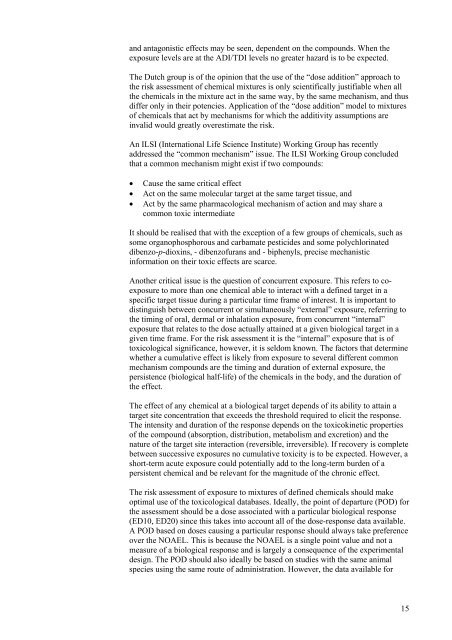Combined Actions and Interactions of Chemicals in Mixtures
Combined Actions and Interactions of Chemicals in Mixtures
Combined Actions and Interactions of Chemicals in Mixtures
You also want an ePaper? Increase the reach of your titles
YUMPU automatically turns print PDFs into web optimized ePapers that Google loves.
<strong>and</strong> antagonistic effects may be seen, dependent on the compounds. When the<br />
exposure levels are at the ADI/TDI levels no greater hazard is to be expected.<br />
The Dutch group is <strong>of</strong> the op<strong>in</strong>ion that the use <strong>of</strong> the “dose addition” approach to<br />
the risk assessment <strong>of</strong> chemical mixtures is only scientifically justifiable when all<br />
the chemicals <strong>in</strong> the mixture act <strong>in</strong> the same way, by the same mechanism, <strong>and</strong> thus<br />
differ only <strong>in</strong> their potencies. Application <strong>of</strong> the “dose addition” model to mixtures<br />
<strong>of</strong> chemicals that act by mechanisms for which the additivity assumptions are<br />
<strong>in</strong>valid would greatly overestimate the risk.<br />
An ILSI (International Life Science Institute) Work<strong>in</strong>g Group has recently<br />
addressed the “common mechanism” issue. The ILSI Work<strong>in</strong>g Group concluded<br />
that a common mechanism might exist if two compounds:<br />
• Cause the same critical effect<br />
• Act on the same molecular target at the same target tissue, <strong>and</strong><br />
• Act by the same pharmacological mechanism <strong>of</strong> action <strong>and</strong> may share a<br />
common toxic <strong>in</strong>termediate<br />
It should be realised that with the exception <strong>of</strong> a few groups <strong>of</strong> chemicals, such as<br />
some organophosphorous <strong>and</strong> carbamate pesticides <strong>and</strong> some polychlor<strong>in</strong>ated<br />
dibenzo-p-diox<strong>in</strong>s, - dibenz<strong>of</strong>urans <strong>and</strong> - biphenyls, precise mechanistic<br />
<strong>in</strong>formation on their toxic effects are scarce.<br />
Another critical issue is the question <strong>of</strong> concurrent exposure. This refers to coexposure<br />
to more than one chemical able to <strong>in</strong>teract with a def<strong>in</strong>ed target <strong>in</strong> a<br />
specific target tissue dur<strong>in</strong>g a particular time frame <strong>of</strong> <strong>in</strong>terest. It is important to<br />
dist<strong>in</strong>guish between concurrent or simultaneously “external” exposure, referr<strong>in</strong>g to<br />
the tim<strong>in</strong>g <strong>of</strong> oral, dermal or <strong>in</strong>halation exposure, from concurrent “<strong>in</strong>ternal”<br />
exposure that relates to the dose actually atta<strong>in</strong>ed at a given biological target <strong>in</strong> a<br />
given time frame. For the risk assessment it is the “<strong>in</strong>ternal” exposure that is <strong>of</strong><br />
toxicological significance, however, it is seldom known. The factors that determ<strong>in</strong>e<br />
whether a cumulative effect is likely from exposure to several different common<br />
mechanism compounds are the tim<strong>in</strong>g <strong>and</strong> duration <strong>of</strong> external exposure, the<br />
persistence (biological half-life) <strong>of</strong> the chemicals <strong>in</strong> the body, <strong>and</strong> the duration <strong>of</strong><br />
the effect.<br />
The effect <strong>of</strong> any chemical at a biological target depends <strong>of</strong> its ability to atta<strong>in</strong> a<br />
target site concentration that exceeds the threshold required to elicit the response.<br />
The <strong>in</strong>tensity <strong>and</strong> duration <strong>of</strong> the response depends on the toxicok<strong>in</strong>etic properties<br />
<strong>of</strong> the compound (absorption, distribution, metabolism <strong>and</strong> excretion) <strong>and</strong> the<br />
nature <strong>of</strong> the target site <strong>in</strong>teraction (reversible, irreversible). If recovery is complete<br />
between successive exposures no cumulative toxicity is to be expected. However, a<br />
short-term acute exposure could potentially add to the long-term burden <strong>of</strong> a<br />
persistent chemical <strong>and</strong> be relevant for the magnitude <strong>of</strong> the chronic effect.<br />
The risk assessment <strong>of</strong> exposure to mixtures <strong>of</strong> def<strong>in</strong>ed chemicals should make<br />
optimal use <strong>of</strong> the toxicological databases. Ideally, the po<strong>in</strong>t <strong>of</strong> departure (POD) for<br />
the assessment should be a dose associated with a particular biological response<br />
(ED10, ED20) s<strong>in</strong>ce this takes <strong>in</strong>to account all <strong>of</strong> the dose-response data available.<br />
A POD based on doses caus<strong>in</strong>g a particular response should always take preference<br />
over the NOAEL. This is because the NOAEL is a s<strong>in</strong>gle po<strong>in</strong>t value <strong>and</strong> not a<br />
measure <strong>of</strong> a biological response <strong>and</strong> is largely a consequence <strong>of</strong> the experimental<br />
design. The POD should also ideally be based on studies with the same animal<br />
species us<strong>in</strong>g the same route <strong>of</strong> adm<strong>in</strong>istration. However, the data available for<br />
15

















